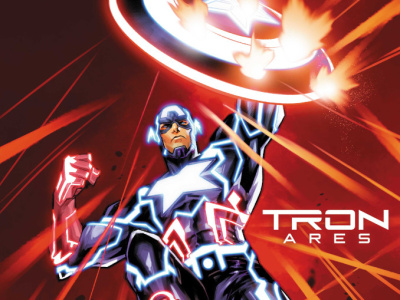Since the beginning of the 2020s, it’s hard to think of two less well-received developments in the world of comics than NFTs and AI. Both carry the vaguely scammy odor of over-hyped boondoggles cooked up by tech bros and VCs to funnel more wealth to themselves at the expense of fans and creators. And both are in the news this week, along with another interesting Marvel Comics digital announcement.
Marvel unveils a new digital strategy. Marvel made news this week with several big announcements made in conjunction with the SXSW technology conference.
The first of these is a repositioning of Marvel Unlimited, the subscription-based digital service that offers unlimited access to Marvel’s archives, to take advantage of vertically-scrolled webtoon-style comics, which have proven to be the most popular format for reading sequential graphic stories on mobile devices.
According to last week’s announcement, Marvel’s new Marvel Infinity: Start Scrolling program is offering free access to 100 titles per month in the new format, with no login required. "Marvel Unlimited’s Infinity Comics were not only introduced to provide a new way to experience Marvel stories, but also to create additional avenues for fresh and under-explored corners of the Marvel Universe," said Jessica Malloy, VP of Marketing, Marvel Unlimited, in the program announcement. "The Start Scrolling program is truly an extension of that. And with titles being rotated in regularly, we hope to keep welcoming in readers to our ever-expanding comic universe!"
Marvel’s approach to this seems smart and uncontroversial. Younger fans of the brand and the characters need a friction-free way to acquire the habit of reading about their favorites in the comics, and the webtoon format is the proven winner on this front. If the content is good and readers like what they see, this is a good way to turn casual fans into comic readers, and potentially comic buyers at retail.
Making digital comics collectible. Marvel’s second big SXSW announcement involves an extension of its partnership with Veve, the standalone Web3 company that has been selling Marvel NFTs since the early 2020s (disclosure: I once had a business relationship with Veve). Veve is launching its own multi-publisher digital reader app, Veve Comics, featuring a day-one partnership with Marvel to sell digital comics that are ownable, collectible and re-sellable thanks to blockchain technology.
"The new comics reader app and webstore fills a current gap in the industry, bringing fans non-subscription access to premium, licensed digital comic books with richer experiences and a fan-centric approach to reading and collecting," says Veve in a release announcing the program.
The announcement emphasizes the fan-friendly and creator-friendly aspects of the technology, particularly its ability to replicate the scarcity and collectability of comics online. This is inarguably something that’s been missing from the digital side, and Marvel is not the only publisher looking into some version of this strategy.
The dirty secret of blockchain. The concept of "digital collectibles" based on blockchain remains controversial because of the sleazy speculative market that developed around NFTs in 2021 and 2022, and the large number of greed-and-hype driven schemes that came crashing down amid numerous "rug pulls," insider manipulation and outright criminality.
But… the flaws of the entrepreneurs and the business models during "web3 v1.0" can’t completely discredit the ultimate value of blockchain technology in the digital economy. Whatever gross stuff took place, it still seems better for individuals to own digital content that they purchased, rather than paying for the "use" (e.g. rental) of digital assets that live on cloud servers that can be arbitrarily altered or shut down. It is better for people to be able to resell digital content that can grow in value through supply and demand, like physical goods, rather than have the platforms totally control all the revenue streams. It is better for these transactions to take place on open ledgers, where you can establish creator rights, ownership and provenance. There is also a colorable argument that blockchain’s ability to keep track of digital assets online can help mitigate some of the biggest problems around AI, specifically in protecting data from unauthorized "scrapes" and in authenticating content so we know what was AI-generated and what wasn’t.
Blockchain-based consumer technology remains a work in progress, and the implementation strategies of companies like Marvel and Veve deserve scrutiny. However, this announcement by Veve also deserves to be considered on its own merits, and the value it could bring to the comics economy should not be discounted.
Meanwhile, AI continues to embarrass. I once heard an economist tell what passes for a joke in that field. He said a colleague asked how his wife was doing, and, following his training, he answered, "compared to what?"
That comes to mind because, whatever we can say about blockchain and NFTs, generative AI will always make it look like the lesser evil by comparison, especially in the creative industries.
This week we have two alleged examples of AI-generated artwork making an unwelcome appearance in the comics space. The first surrounds the "Spawnuary" contest sponsored by Todd McFarlane, asking fans to create their own versions of some of the franchise’s iconic characters in hopes of gaining recognition and the possibility of publication. Several comics YouTubers noted that one of the winning entries was produced by someone whose Instagram feed shows a lot of AI-generated work, triggering a firestorm of condemnation from fans and professionals. The person who produced the work denies using AI for that particular image.
At the same time, online sleuths believe they have uncovered evidence that AI-generated art was used in DC Comics’ Batman #143, in violation of DC policy. Artist James Leach posted the allegations on X (formerly Twitter) on March 10, writing "Now that I’ve read all the issues of Batman that [artist Andrea Sorrentino] contributed to, I feel like there’s a pretty strong case that AI Art is being used. I’d love to be wrong about this, especially as the run has been so great, but it’s hard to avoid." DC has said it is looking into the matter.
Both of these examples came under suspicion through the clumsiness of their execution and the failure of the "creators" to cover their tracks sufficiently. This feels like a temporary problem, especially as the technology improves and the users of it become cagier about getting caught in the act.
Outrage helps. While companies may have issues with fans and professionals policing their adoption of new technologies, it feels to me like it helps more than it hurts. The online backlash to the abuses of the NFT era helped warn companies away from investments in unproven technology and business models that would likely have proven disastrous.
The same outrage we’ve seen mobilized by creators against generative AI trained on artwork without consent or compensation, with a view toward de-skilling creative professions, transferring more power to publishers and drowning the market in bland, derivative AI-generated content, is having the same effect, by shaming and exposing cynical practitioners.
Today’s blockchain-based digital collectibles ventures are approaching the market with considerably more humility thanks to that backlash, and consequently stand a better chance of realizing some actual benefits for the industry beyond just making a few tech bros a little bit richer. Hopefully the same can one day be said of generative AI, once the current bubble of hype runs aground.
The opinions expressed in this column are solely those of the writer, and do not necessarily reflect the views of the editorial staff of ICv2.com.
Rob Salkowitz is the author of Comic-Con and the Business of Pop Culture and an Eisner-Award nominee.

Column by Rob Salkowitz
Posted by Rob Salkowitz on March 18, 2024 @ 2:42 pm CT
MORE COMICS
At AnimeNYC
August 22, 2025
The winners of the 2025 American Manga Awards, organized by AnimeNYC owner LeftField Media and Japan Society, were announced in a ceremony at AnimeNYC in New York on August 21.
From Marvel Comics
August 22, 2025
This October, Marvel Comics celebrates the release of TRON: Ares with new variant covers.
MORE COLUMNS
Column by Jeffrey Dohm-Sanchez
August 21, 2025
ICv2 Managing Editor Jeffrey Dohm-Sanchez continues to take a look at some of the issues revolving around Universes Beyond products.
Column by Rob Salkowitz
August 19, 2025
For Horror Week, columnist Rob Salkowitz asks whether the horror boom can help get us through a moment full of woe and dread.










